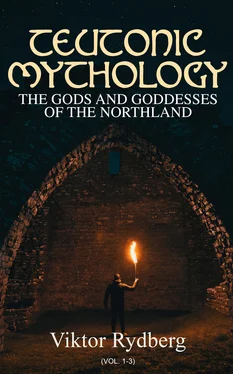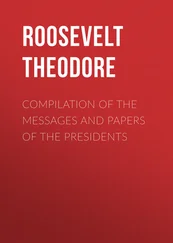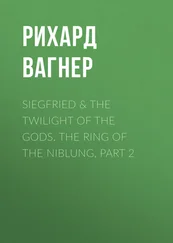Viktor Rydberg - Teutonic Mythology - The Gods and Goddesses of the Northland (Vol. 1-3)
Здесь есть возможность читать онлайн «Viktor Rydberg - Teutonic Mythology - The Gods and Goddesses of the Northland (Vol. 1-3)» — ознакомительный отрывок электронной книги совершенно бесплатно, а после прочтения отрывка купить полную версию. В некоторых случаях можно слушать аудио, скачать через торрент в формате fb2 и присутствует краткое содержание. Жанр: unrecognised, на английском языке. Описание произведения, (предисловие) а так же отзывы посетителей доступны на портале библиотеки ЛибКат.
- Название:Teutonic Mythology: The Gods and Goddesses of the Northland (Vol. 1-3)
- Автор:
- Жанр:
- Год:неизвестен
- ISBN:нет данных
- Рейтинг книги:4 / 5. Голосов: 1
-
Избранное:Добавить в избранное
- Отзывы:
-
Ваша оценка:
- 80
- 1
- 2
- 3
- 4
- 5
Teutonic Mythology: The Gods and Goddesses of the Northland (Vol. 1-3): краткое содержание, описание и аннотация
Предлагаем к чтению аннотацию, описание, краткое содержание или предисловие (зависит от того, что написал сам автор книги «Teutonic Mythology: The Gods and Goddesses of the Northland (Vol. 1-3)»). Если вы не нашли необходимую информацию о книге — напишите в комментариях, мы постараемся отыскать её.
One of Rydberg's mythological theories developed in this book is that of a vast World Mill which rotates the heavens, which he believed was an integral part of Old Norse mythic cosmology.
Teutonic Mythology: The Gods and Goddesses of the Northland (Vol. 1-3) — читать онлайн ознакомительный отрывок
Ниже представлен текст книги, разбитый по страницам. Система сохранения места последней прочитанной страницы, позволяет с удобством читать онлайн бесплатно книгу «Teutonic Mythology: The Gods and Goddesses of the Northland (Vol. 1-3)», без необходимости каждый раз заново искать на чём Вы остановились. Поставьте закладку, и сможете в любой момент перейти на страницу, на которой закончили чтение.
Интервал:
Закладка:
To begin with, there was no doubt that the original tongue itself, the mother of all the other Aryan languages, had already been found when Zend or Sanscrit was discovered. Fr. v. Schlegel, in his work published in 1808, on the Language and Wisdom of the Hindoos , regarded Sanscrit as the mother of the Aryan family of languages, and India as the original home of the Aryan family of peoples. Thence, it was claimed, colonies were sent out in prehistoric ages to other parts of Asia and to Europe; nay, even missionaries went forth to spread the language and religion of the mother-country among other peoples. Schlegel's compatriot Link looked upon Zend as the oldest language and mother of Sanscrit, and the latter he regarded as the mother of the rest; and as the Zend, in his opinion, was spoken in Media and surrounding countries, it followed that the highlands of Media, Armenia, and Georgia were the original home of the Aryans, a view which prevailed among the leading scholars of the age, such as Anquetil-Duperron, Herder, and Heeren, and found a place in the historical text-books used in the schools from 1820 to 1840.
Since Bopp published his epoch-making Comparative Grammar the illusion that the Aryan mother-tongue had been discovered had, of course, gradually to give place to the conviction that all the Aryan languages, Zend and Sanscrit included, were relations of equal birth. This also affected the theory that the Persians or Hindoos were the original people, and that the cradle of our race was to be sought in their homes.
On the other hand, the Hindooic writings were found to contain evidence that, during the centuries in which the most of the Rigveda songs were produced, the Hindooic Aryans were possessors only of Kabulistan and Pendschab, whence, either expelling or subjugating an older black population, they had advanced toward the Ganges. Their social condition was still semi-nomadic, at least in the sense that their chief property consisted in herds, and the feuds between the clans had for their object the plundering of such possessions from each other. Both these facts indicated that these Aryans were immigrants to the Indian peninsula, but not the aborigines, wherefore their original home must be sought elsewhere. The strong resemblance found between Zend and Sanscrit, and which makes these dialects a separate subdivision in the Aryan family of languages, must now, since we have learned to regard them as sister-tongues, be interpreted as a proof that the Zend people or Iranians and the Sanscrit people or Hindoos were in ancient times one people with a common country, and that this union must have continued to exist long after the European Aryans were parted from them and had migrated westwards. When, then, the question was asked where this Indo-Iranian cradle was situated, the answer was thought to be found in a chapter of Avesta, to which the German scholar Rhode had called attention already in 1820. To him it seemed to refer to a migration from a more northerly and colder country. The passage speaks of sixteen countries created by the fountain of light and goodness, Ormuzd (Ahura Mazda), and of sixteen plagues produced by the fountain of evil, Ahriman (Angra Mainyu), to destroy the work of Ormuzd. The first country was a paradise, but Ahriman ruined it with cold and frost, so that it had ten months of winter and only two of summer. The second country, in the name of which Sughda Sogdiana was recognised, was rendered uninhabitable by Ahriman by a pest which destroyed the domestic animals. Ahriman made the third (which by the way, was recognised as Merv) impossible as a dwelling on account of never-ceasing wars and plunderings. In this manner thirteen other countries with partly recognisable names are enumerated as created by Ormuzd, and thirteen other plagues produced by Ahriman. Rhode's view, that these sixteen regions were stations in the migration of the Indo-Iranian people from their original country became universally adopted, and it was thought that the track of the migration could now be followed back through Persia, Baktria and Sogdiana, up to the first region created by Ormuzd, which, accordingly, must have been situated in the interior highlands of Asia, around the sources of the Jaxartes and Oxus. The reason for the emigration hence was found in the statement that, although Ormuzd had made this country an agreeable abode, Ahriman had destroyed it with frost and snow. In other words, this part of Asia was supposed to have had originally a warmer temperature, which suddenly or gradually became lower, wherefore the inhabitants found it necessary to seek new homes in the West and South.
The view that the sources of Oxus and Jaxartes are the original home of the Aryans is even now the prevailing one, or at least the one most widely accepted, and since the day of Rhode it has been supported and developed by several distinguished scholars. Then Julius v. Klaproth pointed out, already in 1830, that, among the many names of various kinds of trees found in India, there is a single one which they have in common with other Aryan peoples, and this is the name of the birch. India has many kinds of trees that do not grow in Central Asia, but the birch is found both at the sources of the Oxus and Jaxartes, and on the southern spurs of the Himalaya mountains. If the Aryan Hindoos immigrated from the highlands of Central Asia to the regions through which the Indus and Ganges seek their way to the sea, then it is natural, that when they found on their way new unknown kinds of trees, then they gave to these new names, but when they discovered a tree with which they had long been acquainted, then they would apply the old familiar name to it. Mr. Lassen, the great scholar of Hindooic antiquities, gave new reasons for the theory that the Aryan Hindoos were immigrants, who through the western pass of Hindukush and through Kabulistan came to Pendschab, and thence slowly occupied the Indian peninsula. That their original home, as well as that of their Iranian kinsmen, was that part of the highlands of Central Asia pointed out by Rhode, he found corroborated by the circumstance, that there are to be found there, even at the present time, remnants of a people, the so-called Tadchiks, who speak Iranian dialects. According to Lassen, these were to be regarded as direct descendants of the original Aryan people, who remained in the original home, while other parts of the same people migrated to Baktria or Persia and became Iranians, or migrated down to Pendschab and became Hindoos, or migrated to Europe and became Celts, Greco-Italians, Teutons, and Slavs. Jacob Grimm, whose name will always be mentioned with honour as the great pathfinder in the field of Teutonic antiquities, was of the same opinion; and that whole school of scientists who were influenced by romanticism and by the philosophy of Schelling made haste to add to the real support sought for the theory in ethnological and philological facts, a support from the laws of natural analogy and from poetry. A mountain range, so it was said, is the natural divider of waters. From its fountains the streams flow in different directions and irrigate the plains. In the same manner the highlands of Central Asia were the divider of Aryan folk-streams, which through Baktria sought their way to the plains of Persia, through the mountain passes of Hindukush to India, through the lands north of the Caspian Sea to the extensive plains of modern Russia, and so on to the more inviting regions of Western Europe. The sun rises in the east, ex oriente lux ; the highly-gifted race, which was to found the European nations, has, under the guidance of Providence, like the sun, wended its way from east to west. In taking a grand view of the subject, a mystic harmony was found to exist between the apparent course of the sun and the real migrations of people. The minds of the people dwelling in Central and Eastern Asia seemed to be imbued with a strange instinctive yearning. The Aryan folk-streams, which in prehistoric times deluged Europe, were in this respect the forerunners of the hordes of Huns which poured in from Asia, and which in the fourth century gave the impetus to the Teutonic migrations, and of the Mongolian hordes which in the thirteenth century invaded our continent. The Europeans themselves are led by this same instinct to follow the course of the sun: they flow in great numbers to America, and these folk-billows break against each other on the coasts of the Pacific Ocean. "At the breast of our Asiatic mother," thus exclaimed, in harmony with the romantic school, a scholar with no mean linguistic attainments—"at the breast of our Asiatic mother, the Aryan people of Europe have rested; around her as their mother they have played as children. There or nowhere is the playground; there or nowhere is the gymnasium of the first physical and intellectual efforts on the part of the Aryan race."
Читать дальшеИнтервал:
Закладка:
Похожие книги на «Teutonic Mythology: The Gods and Goddesses of the Northland (Vol. 1-3)»
Представляем Вашему вниманию похожие книги на «Teutonic Mythology: The Gods and Goddesses of the Northland (Vol. 1-3)» списком для выбора. Мы отобрали схожую по названию и смыслу литературу в надежде предоставить читателям больше вариантов отыскать новые, интересные, ещё непрочитанные произведения.
Обсуждение, отзывы о книге «Teutonic Mythology: The Gods and Goddesses of the Northland (Vol. 1-3)» и просто собственные мнения читателей. Оставьте ваши комментарии, напишите, что Вы думаете о произведении, его смысле или главных героях. Укажите что конкретно понравилось, а что нет, и почему Вы так считаете.











